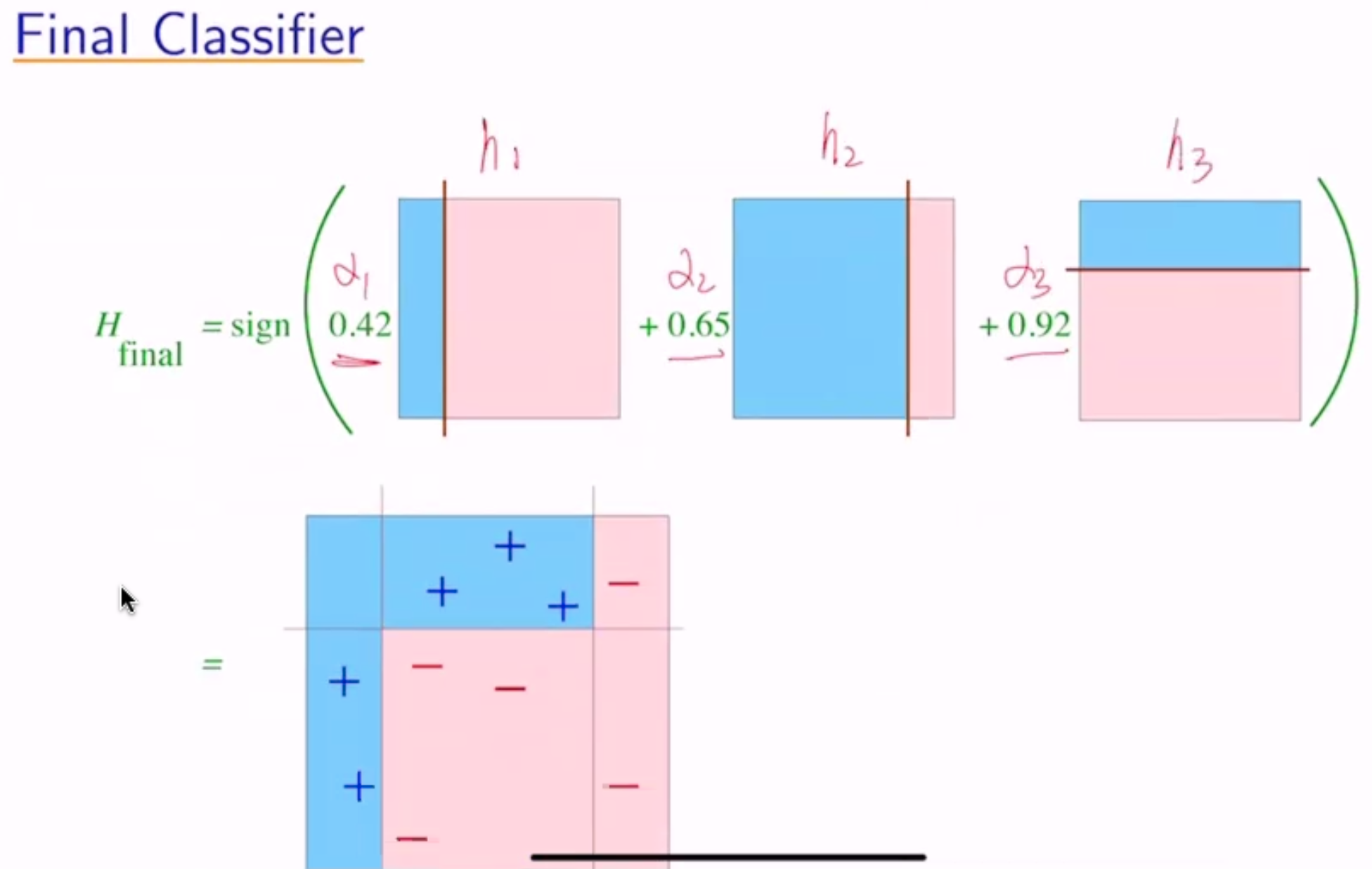Ensemble/Boosting¶
Ensemble Methods¶
- use an ensemble/group of hypotheses
- diversity important; ensemble of “yes-men” is useless
- get diverse hypotheses by using
- different data
- different algorithms
- different hyperparameters
Why?
- averaging reduces variance
- ensemble more stables than individual
- consider biased coin p(head) = 1/3
- variance on one flip = 1/3 - 1/9 = 2/9
- variance on average of 2 flips = 2/9 - 1/9 = 1/9
- averaging makes less mistakes
- consider 3 classifiers with accuracy 0.8, 0.7, and 0.7
- the probability that the majority vote is correct = (f1 correct, f2 correct, f3 wrong) + (f1 correct, f2 wrong, f3 correct) + (f1 wrong, f2 correct, f3 correct) + (f1 correct, f2 correct, f3 correct)
- = \((.8*.7*.3) + (.8*.3*.3) + (.2*.7*.7) + (.8*.8*.7) \approx 0.82\)
Creation¶
- use different training sets
- bootstrap example: pick m examples from labeled data with replacement
- cross-validation sampling
- reweight data (boosting, later)
- use different features
- random forests “hide” some features
Prediction¶
- unweighted vote
- weighted vote
- pay more attention to better predictors
- cascade
- filter examples; each level predicts or passes on
Boosting¶
- “boosts” the preformance of another learning algorithm
- creates a set of classifiers and predicts with weighted vote
- use different distributions on sample to get diversity
- up-weight hard, down-weight easy examples
- note: ensembles used before to reduce variance

If boosting is possible, then:
- can use fairly wild guesses to produce highly accurate predictions
- if you can learn “part way” you can learn “all the way”
- should be able to improve any learning algorithm
- for any learning problem:
- either can learn always with nearly perfect accuracy
- or there exist cases where cannot learn even slightly better than random guessing
Ada-Boost¶
Given a training sample S with labels +/-, and a learning algorithm L:
- for t from 1 to T do
- create distribution \(D_t\) on \(S\)
- call \(L\) with \(D_t\) on \(S\) to get hypothesis \(h_t\)
- i.e. \(\min \sum_n D_t(n) l(f(x_n), y_n)\) where \(D_t(n)\) is the weight of the sample
- calculate weight \(\alpha_t\) for \(h_t\)
- final hypothesis is \(F(x) = \sum_t \alpha_t h_t(x)\), or \(H(x)\) = value with most weight
formally:

So how do we pick \(D_t\) and \(\alpha_t\)?
- \(D_1(i) = 1/m\) - the weight assigned to \((x_i, y_i)\) at \(t=1\)
- given \(D_t\) and \(h_t\):
- \(D_{t+1}(i) = \frac{D_t(i)}{Z_t} \exp(-\alpha_t y_i h_t(x_i))\)
- if correct, increase weights by a factor > 1 (positive exponential)
- otherwise decrease by a factor < 1 (negative exponential)
- where \(Z_t\) is a normalization factor
- where \(\alpha_t = \frac{1}{2} \ln (\frac{1-\epsilon_t}{\epsilon_t}) > 0\)
- \(H_{final}(x) = sign(\sum_t \alpha_t h_t(x))\)
Example:

now the weights become \(\frac{1}{10} e^{0.42}\) for the misclassified and \(\frac{1}{10} e^{-0.42}\) for the correct



Analyzing Error¶
Thm: Write \(\epsilon_t\) as \(1/2 - \gamma_t\) - \(\gamma_t\) = “edge” = how much better than random guessing. Then:
So if \(\forall t: \gamma_t \geq \gamma > 0\), then \(\text{training error}(H_{final}) \leq e^{-2\gamma^2 T}\)
therefore, as \(T \to \infty\), training error \(\to 0\)
Proof¶
Let \(F(x) = \sum_t \alpha_t h_t(x) \to H_{final}(x) = sign(F(x))\)
Step 1: unwrapping recurrence
Step 2: training error \((H_{final}) \leq \prod_t Z_t\)
Step 3: \(Z_t = 2 \sqrt{\epsilon_t (1-\epsilon_t)}\)
Discussion¶
We expect even as training error approaches 0 as T increases, the test error won’t - overfitting!
We can actually predict “generalization error” (basically test error):
Where \(m\) = # of training samples, \(d\) = “complexity” of weak classifiers, \(T\) = # of rounds
But in reality, it’s not always a tradeoff between training error and test error.
Margin Approach¶
- training error only measures whether classifications are right or wrong
- should also consider confidence of classifications
- \(H_{final}\) is weighted majority vote of weak classifiers
- measure confidence by margin = strength of the vote
- = (weighted fraction voting correctly) - (weighted fraction voting incorrectly)
- so as we train more, we increase the margin, which leads to a decrease in test loss
- both AdaBoost and SVMs
- work by maximizing margins
- find linear threshold function in high-dimensional space
- but they use different norms
AdaBoost is:
- fast
- simple, easy to program
- no hyperparameters (except T)
- flexible, can combine with any learning algorithm
- no prior knowledge needed about weak learner
- provably effective (provided a rough rule of thumb)
- versatile
But:
- performance depends on data and weak learner
- consistent with theory, adaboost can fail if:
- weak classifiers too complex (overfitting)
- weak classifiers too weak (basically random guessing)
- underfitting, or low margins -> overfitting
- susceptible to uniform noise